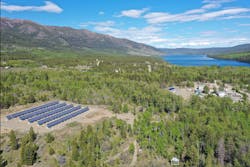Microgrid Saves Money, Cuts Carbon for First Nation Community in British Columbia
Sixty-two miles from the nearest electricity grid, the Xeni Gwet’in First Nation has completed a renewable energy microgrid in remote British Columbia, Canada, with the help of Amp Energy.
Built in collaboration with the Xeni Gwet’in chief and community leaders, the Amp Energy microgrid is located in Nemiah Valley, an unincorporated ranching community and First Nation reserve located between Chiko Lake and the Taseko Lakes.
Providing power to 28 homes in the area, the new microgrid consists of 250 kW of installed solar PV capacity and charges 1,000 kWh of battery storage.
In a community that has only had generator electricity since 2006, the microgrid will provide residents with reliable access to power 24 hours a day, opening the door to prolonged food preservation, lights, Wi-Fi and more.
Project developers expect the microgrid to reduce the community’s reliance on fossil fuels by 60% and displace approximately 8,847 gallons of diesel and 4,200 tons of carbon dioxide annually.
The microgrid will not only reduce the Xeni Gwet’in First Nation’s carbon emissions but will also lower the local cost of energy. Amp Energy estimates that community members who had previously been paying $0.40/kWh will now be able to purchase electricity at a rate of approximately $0.15/kWh.
Serving as the project’s general contractor, Amp Energy is a global clean energy developer with headquarters in Toronto, Canada. During a feasibility study with the University of Prince Edward Island, the Xeni Gwet’in community was introduced to Amp Energy through a professor who had been working with the company training staff on battery storage.
To complete the project, Amp Energy collaborated with subcontractors Eaton, Echo-H Technologies (part of the AVL Group), and the local Xeni Gwet’in Enterprise, which is the business arm of the First Nation’s government.
Funding for the project came from the Fraser Basin Council’s Renewable Energy for Remote Communities program, as well as the British Columbia Indigenous Clean Energy Initiative from the New Relationship Trust, an independent nonprofit.
After training from Amp Energy, the Xeni Gwet’in Enterprise will maintain the microgrid while it is monitored by the University of Prince Edward Island.
Currently, the project’s developers are looking into the possibility of wind turbine installation in 2022 to further offset the community’s diesel consumption.
Get the latest news on sustainable microgrids around the world with the free Microgrid Knowledge newsletter.







